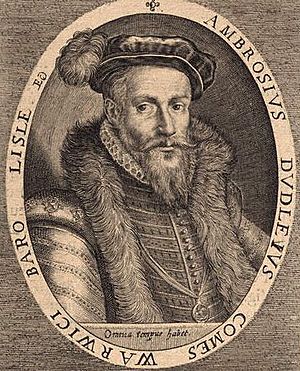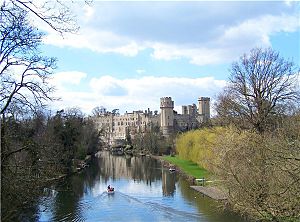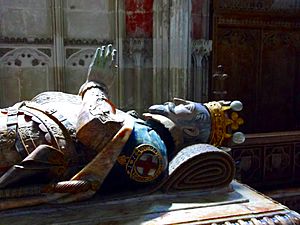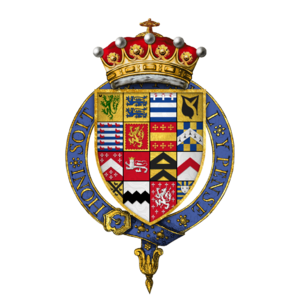Ambrose Dudley, 3rd Earl of Warwick facts for kids
Quick facts for kids
Ambrose Dudley
|
|
|---|---|

Engraving by Willem de Passe, 1620, after an earlier portrait
|
|
| Born | c. 1530 |
| Died | 21 February 1590 London |
| Resting place | Collegiate Church of St Mary, Warwick |
| Title | Earl of Warwick |
| Tenure | 1561–1590 |
| Other titles | Baron Lisle |
| Nationality | English |
| Residence | Warwick Castle, Warwickshire North Hall, Northaw, Hertfordshire |
| Locality | West Midlands |
| Wars and battles | Kett's Rebellion Campaign against Mary Tudor, 1553 Battle of St. Quentin, 1557 Newhaven Campaign, 1562–1563 Rising of the North |
| Offices | Master of the Ordnance Privy Councillor |
| Spouse(s) | Anne Whorwood Elizabeth Tailboys, 4th Baroness Tailboys Anne Russell |
| Parents | John Dudley, 1st Duke of Northumberland Jane Guildford |
| Signature | |
 |
|
Ambrose Dudley, the 3rd Earl of Warwick, was an important English nobleman and general. He was born around 1530 and died on February 21, 1590. Ambrose was the older brother of Robert Dudley, Earl of Leicester, who was a close friend of Queen Elizabeth I.
Their father, John Dudley, 1st Duke of Northumberland, was a powerful leader in England from 1550 to 1553. After King Edward VI died in 1553, their father tried to make Lady Jane Grey queen. This plan failed, and Ambrose was sent to the Tower of London and faced serious punishment.
However, he was later set free. His chance to return to royal favor came when he fought for Philip II of Spain in the Battle of St. Quentin in 1557. When Queen Elizabeth I became queen in 1558, Ambrose Dudley was given an important job. He became the Master-General of the Ordnance, in charge of weapons and military supplies.
In 1561, he was given the title Earl of Warwick. From 1562 to 1563, he led an English army to Le Havre in France to help the Huguenots (French Protestants) during a religious war. This mission was difficult and ended when many English soldiers got sick. Ambrose was badly wounded in the leg, which affected him for the rest of his life. His last military action was against rebels in northern England in 1569. From 1573, he was a member of the Privy Council, advising the Queen.
Ambrose Dudley was married three times but had no children who survived. He was very close to his brother Robert. Both brothers supported the Puritan movement, which wanted to reform the Church of England. Because of his quiet and honest way of life, Ambrose Dudley became known as the "Good Earl of Warwick."
Contents
Early Life and Challenges
Ambrose Dudley was the fourth son of Sir John Dudley and Jane Guildford. His family had 13 children and was known for being Protestant and having a happy home. Ambrose and his brothers were taught by smart people like the mathematician John Dee.
In 1549, Ambrose and his younger brother Robert helped their father fight against a peasant uprising led by Robert Kett. After this, Ambrose was made a knight. He married Anne Whorwood, but she and their baby daughter both died in 1552. Soon after, he married Elizabeth Tailboys, a wealthy baroness.
The Failed Plan of 1553
After King Edward VI died in 1553, Ambrose's father, the Duke of Northumberland, tried to make Lady Jane Grey queen. She was a Protestant cousin of the King. However, Mary Tudor (King Edward's half-sister) claimed the throne. Ambrose and his older brother John went with their father to fight against Mary.
But Mary gained more support, and the plan failed. Ambrose, his father, and his four brothers were arrested and sent to the Tower of London. They were found guilty of treason, which meant they lost their rights and faced serious punishment. Only his father and his brother Guildford were executed.
Ambrose stayed in the Tower the longest. He was released in late 1554, thanks to his wife and his brother-in-law, Henry Sidney. They asked for help from Spanish nobles who were close to England's new co-ruler, Philip II of Spain.
Return to Favor
After being released, Ambrose and Robert Dudley took part in tournaments held by King Philip. Ambrose's mother died in 1555, and Queen Mary allowed him to inherit her lands. However, the Dudley brothers were only welcome at court when King Philip was there.
In 1557, Ambrose and Robert joined the Spanish army in France. They fought in the Battle of St. Quentin, where their brother Henry was killed. Because of their service, the two surviving brothers were given back their full rights by Parliament in 1558. However, this war made Ambrose and his wife almost bankrupt.
Serving Queen Elizabeth I

When Elizabeth I became queen in November 1558, Robert Dudley became very important. Ambrose Dudley was made Master-General of the Ordnance, managing the country's weapons.
In 1558, the Dudley brothers gave up their claims to their father's old titles and lands. But in December 1561, Ambrose was given the titles of Baron Lisle and Earl of Warwick. He also received many of the lands that had been taken from his father. Warwick Castle became his home.
The French Campaign
In 1562, a religious war started in France. Queen Elizabeth's advisors wanted her to help the Huguenots (French Protestants). The Huguenots controlled the town of Le Havre and offered it to England for military help. Elizabeth sent 6,000 soldiers to Le Havre, and Ambrose Dudley was chosen to lead them.
Warwick arrived in Le Havre in late October 1562. He was worried about holding the town. Elizabeth did not want his army to fight directly for the Huguenots. In March 1563, the French groups made peace with each other. Then, they both turned against the English soldiers in Le Havre.
Warwick tried his best, but the town's walls were falling apart from French attacks. Many of his soldiers were also dying from the plague. In July 1563, the Queen allowed him to surrender. Ambrose was shot in the leg during a meeting with the French and returned to England very sick.
Even though the mission was a political failure, Warwick was praised for his leadership. His soldiers had good spirits, and he treated the local people with respect. He was given the Welsh lordship of Ruthin and the Order of the Garter. His leg injury never fully healed, which limited his future military roles.
While he was in France, his second wife, Elizabeth Tailboys, died. On November 11, 1565, Ambrose married for the third time. His new wife was 16-year-old Anne Russell, whose father was the Earl of Bedford. His brother Robert helped arrange this marriage. It was a big event at court, and Anne later became a close friend of Queen Elizabeth.
Later Service
In November 1569, a rebellion broke out in northern England. The rebels wanted to put Mary, Queen of Scots on the English throne. The Earl of Warwick was one of the commanders sent to stop the revolt. Because of his poor health, he soon returned home.
As Master of the Ordnance, Warwick was in charge of the country's weapons and supplies. He secretly helped William the Silent, a Dutch leader, by sending him English cannons to use against Spanish rule in the Netherlands.
In 1573, Warwick became a member of the Privy Council, advising the Queen. He attended meetings regularly until his health got worse in the 1580s. In 1587, he was part of the trial of Mary, Queen of Scots.
Private Life and Legacy

Ambrose Dudley was a major supporter of the Puritan movement. He helped preachers who were having trouble with the official Church. For example, he helped the preacher John Field when he was imprisoned for publishing a book.
Ambrose and his brother Robert were very close. Ambrose said that no one knew Robert's actions better than he did. Robert often said, "him I love as myself." Queen Elizabeth liked Warwick and joked that he wasn't as graceful or handsome as his brother.
Ambrose didn't have a large home in London. He had rooms in his brother Robert's grand house, Leicester House. The brothers also shared their land managers and lawyers. They spent as much time together as they could.
Ambrose Dudley had no children who survived. His second wife, Elizabeth, had a false pregnancy in 1555. His third wife, Anne Russell, was a good partner for him. The Dudley brothers were proud of their family history, especially their connection to the old Earls of Warwick.
Ambrose's lack of children worried his brother Robert. Robert also died without direct heirs in 1588. Most of Robert's property and debts went to Ambrose, which made his last years difficult. Ambrose also took care of Robert's young son, Robert, who was his godson.
From the 1570s, the Earl of Warwick often lived at North Hall in Northaw, Hertfordshire. He traveled little because he often couldn't use his legs. In January 1590, his leg had to be amputated because it was infected. He died on February 21.
Ambrose Dudley was buried in the Beauchamp Chapel of Collegiate Church of St Mary, Warwick. His wife had a monument built for him. Ambrose Dudley is remembered as the "Good Earl of Warwick" because of his quiet life, which was different from his famous brother.
See also


